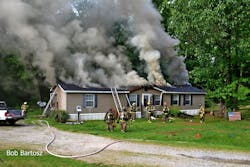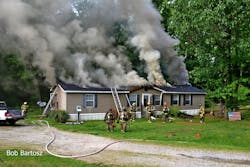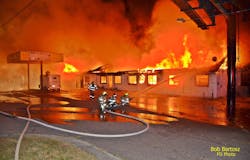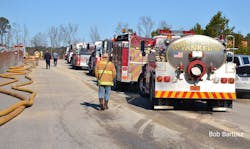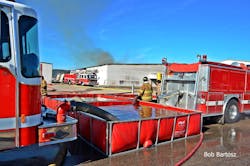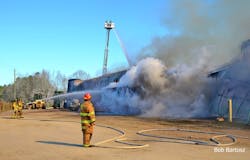Gaining knowledge of fire science and a background understanding of crew management is a necessity in all organizations, regardless of being paid or volunteer, urban or rural. Once these foundations are established based on general best practices, agencies then need to customize their service delivery models and operating guidelines dependent on their specific needs.
Strategies and tactics
Let’s consider the following scenario as an example of doing it the same way, differently:
Two houses were finished being built on the same day in 2018, one on 1234 Forest Lane in rural Oregon and another at 1234 Main Street in suburban Indiana. Each are 2,300-square feet with the same floor plan, same construction, and meet the same building, electrical, and plumbing codes. Each are furnished with modern furnishings bought from the same large chain furniture store and are occupied by a family of four. A fire starts in the living room at the same time of night in both locations, while the family sleeps. They are awakened by the smoke detection system and use their pre-practiced fire escape plans to safely evacuate the home (unfortunately, they did not install residential fire sprinklers, which they should have! But that’s another article…).
In this scenario, the fire will burn in ways consistent with what the Underwriters Laboratory (UL) and International Society of Fire Service Instructors (ISFSI) studies have been depicting the last many years in both locations. The fire will build rapidly due to the volatility of the fuel load in the home, potentially becoming ventilation-limited, or quickly consuming the home in flashover if doors and/or windows are left open. Unfortunately, the situation plays itself out every day throughout the world. The rural agency responding to the incident on Forest Lane in Oregon may use the same strategies as the suburban agency in Indiana, but the tactics could vary widely.
Both agencies approach the fire scene with the idea of performing a 360-degree size-up with a thermal imaging camera (TIC) to locate the fire, identifying and controlling flow paths, and extinguishing the fire in the most efficient and effective manner, all the while placing the life safety of the occupants and firefighters as the top priority. Let’s take a closer look at two of these elements and see where the tactics may differ.
360-degree size-up with a TIC
Most fire service videos on thermal imaging 360-degree size-ups show a full-sized, fire service-certified TIC being used to identify the location of the fire in the building. This is the best way to accomplish this task, but it may not be a reality in rural volunteer agencies with limited resources. Rural volunteer agencies typically have smaller budgets with less opportunity to outfit each apparatus the same way.
Additionally, they do not have the ability to have every officer respond with a TIC on their personal vehicle (if they do POV response) or equip the duty officer vehicle with a TIC in addition to the responding apparatus. However, the first-arriving officer, if POV or in a duty officer vehicle, can have a smaller, handheld TIC that will provide more information than the naked eye. These smaller TICs can be found for less than $400 and are widely used in the electrician and inspection industries to identify warm electrical circuits. The screen is small, it is not meant to be drug through a burning building and is not considered a fire service piece of equipment, but it is better than trying to identify the location of a fire without a TIC. Using tools that are within the budget and practicality of the given department is a necessity.
Fire extinguishment
During the Spartanburg, SC, research burns by the ISFSI and UL Fire Science Research Institute (FSRI), the late, great fire chief Alan Brunacini wrote that the “best water is the fastest water.” This pertains to residential fire sprinklers (again, another article!) and rapid application of water on fire by whatever means possible. Both types of agencies have this goal in mind, however three factors create a different situation for rural environments than suburban areas: response time, water supply, and staffing (addressed in the next section).UL-FSRI research has shown that homes can reach flashover conditions in as little as 3 minutes from the time of ignition, if a source of oxygen/air can reach the fire. This time frame is under the response time for almost any agency for most of their fires. What this means for rural agencies is that the home they are responding to may be substantially consumed in fire and may have impending floor and roof collapse if it has not happened prior to arrival. Urban and suburban departments often arrive with a shorter response time, decreasing the amount of structural burn-through already completed. This is an important factor for rural fireground leaders to consider when choosing tactics.
As with all interior fire operations, floor stability, situational awareness and continuous flow path monitoring is highly important. The suburban and urban departments can arrive, apply a fast water application from the exterior and get inside to finish off the fire with a higher level of structural confidence due to fire impingement on structural members being potentially less (they still need to be hyper-vigilant in their assessment of the structural integrity). Rural agencies on the other hand, may need to apply more water from the exterior due to fire involvement in the structure before making an interior attack to finish the extinguishment. The interior portion of the attack must be carefully executed due to longer fire impingement on structural members and a higher potential for collapse. This creates a need for rural agencies to practice exterior application of water for longer durations and from multiple access points prior to interior attack. No, I’m not saying that rural firefighters should never do interior fire attack; I’m saying that interior fire attack brings higher risk to rural firefighters that arrive later into fire development and often time have less live fire experience. Also, rural firefighters who are entering homes that have been on fire for a longer period need to have a very good understanding of fire dynamics and the effect of fire on structures in later stages of decay, as this is when they are routinely entering the homes.Crew resource management
We would all love to have three 4-person engine companies, a 5-person truck company, a battalion chief, safety officer, and dedicated EMS/rehab unit respond to every first alarm fire call we have. However, it is not a common reality for any rural agency to have that many resources in the first 10 minutes of an incident. So, crew resource management is a different animal in the rural volunteer fire service. Often, firefighters are not arriving in engine companies, but in personal vehicles to be assembled at the scene. This poses the difficult task of not knowing how many firefighters and apparatus are going to show up, how to manage incidents with minimal command staff, and how to track accountability. Many rural fire officers are good at managing these tasks since this is the system that they were trained in, however, most fire service training videos do not show this as a reality in their depiction of fire attack operations.
1- and 2-person engine companies
The reality in many rural agencies is that the apparatus arriving is staffed with 1 or 2 people, sometimes not even certified firefighters, but apparatus operators and support personnel (scene support, student firefighters, recruits, etc.). These crews must be trained on what to do upon arrival at the above fire scenario. They can deploy fast attack lines, 2½-inch pre-plumbed quick-attack standalone nozzles and do other non-interior attack operations. For this to be effective, you must train on this scenario. How many times do you do weekly fire training with pre-staffed 3- and 4-person engine companies arriving at the scene of your training scenario? This is an incorrect way of training unless it is a reality in response. Don’t be afraid to set training up in the manner that you respond, having small engine companies with staggered arrival of firefighters. It is realistic and creates conditions that the agency will see when responding to real emergencies. This takes more planning on the training officers’ part, but it is worth the outcome when emergencies happen.
Command staff
Whose responsibility is fireground safety? The incident commander (IC). It is nice and effective to be able to delegate this responsibility to a safety officer, but the accountability always lands with the IC. So, when trained staffing levels do not allow for a safety officer position to be filled at the emergency scene, the IC maintains this responsibility and therefore must fill both positions. Is this ideal? Absolutely not. Is this reality? Absolutely. The IC cannot delegate the safety function to a non-trained and inexperienced person, just to get rid of it. This is more dangerous than having divided attention. Safety of the public and the firefighters is the number one priority on all firegrounds. During training, if you are not usually able to staff a safety officer, the IC needs to practice having this responsibility in addition to maintaining situational awareness, managing operations, water supply, and often dealing with public information requests. Just because more firefighters/members assemble on the weekly drill nights doesn’t mean that you must utilize all of them in roles that will rarely be established on the actual fireground. This creates a false sense of comfort of having all these positions filled for actual responses.
Accountability
Fireground accountability is of utmost importance to maintain situational awareness of your firefighters’ well-being. Staffed apparatus responding to an emergency can use accountability systems designed for this purpose. All personnel on the apparatus place their name tags on some type of collection board in the apparatus and these are in turn handed to an accountability officer or the IC and one copy is kept with the company officer and another in the apparatus. This is one of many types of accountability systems in use throughout the world. However, what do you do when your firefighters are either responding in their POVs or on various apparatus to be parked at the fire scene and not utilized (salvage trucks, staff vehicles, rescues, ambulances, etc.)? Some type of collection/staging area must be established with accountability boards or some other type of name tag collection and company assembly to take place. A couple of variations include a large traffic cone with a pole holding company assignment tags where firefighters place their tags in company groups before entering IDLH atmospheres or a compartment door on each apparatus set up with an accountability board mounted on it to be used by assembling fire crews. Each of these systems, or one that you have designed in your department, must be trained on and enforced! The worst thing to do with accountability is to establish a system and operating guideline and then not enforce its use. This brings complacency, lack of respect of fire officers, and a potential disaster when fireground accountability is needed during an emergency.The same…but different
There are many ways in which the fireground operation is different between rural and urban/suburban agencies. Development of realistic operations, training on tactics and systems that relate to your specific agency, and the implementation of practices that benefit your department and surrounding mutual aid agencies are going to create the most safe, effective, and efficient fireground for YOUR agency. Use caution when patterning your department operations off an agency with vastly different staffing, resources, and environmental factors. Be creative. Share your knowledge. Do things the same way, differently.
About the Author
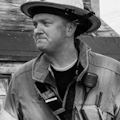
Devon Wells
Devon Wells is the past president of the International Society of Fire Service Instructors (ISFSI) and the emergency response program manager for Tactical Aeronautics in Hood River, OR. He is the former fire chief of Hood River, OR, Fire & EMS and is a 30-year veteran of the fire service. Wells currently volunteers for the Wy'East Fire District in Oregon. He presents nationally on safety, leadership, organizational philosophy and rural fire officer topics. Wells is on the NFPA 1700 committee on Fundamentals of Fire Control within a Structure Utilizing Fire Dynamics. He manages the Rural Fire Officer Facebook page.
